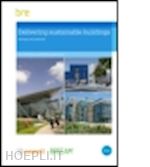Research by Sweett Group and BRE has challenged the perception that sustainable buildings are necessarily more costly to build. By applying cost data from real construction projects to three case study buildings – an office, secondary school and community healthcare centre – detailed capital and operational cost information has been obtained. The project investigated the capital costs of design and construction strategies that enhance building sustainability and help to achieve BREEAM ratings. They include low-cost or no-cost actions that can readily be used to enhance building sustainability (‘quick wins’), and those initiatives that must be built into the project at the concept stage to minimise their costs. Detailed cost information for a wide selection of these actions is presented in this report.The research team also examined the life-cycle costs of operating buildings, focusing on energy and water consumption. They found that specifying sustainability measures during the building’s design and procurement stage can result in cost savings over the operational life of the building for little or no additional upfront cost.The effect on capital costs of achieving varying levels of sustainability was calculated, with the costs associated with gaining Pass, Good, Very Good and Excellent BREEAM ratings outlined in this report. It has been shown that achieving lower BREEAM ratings can incur little or no additional costs. Targeting the higher BREEAM ratings, which equate with more challenging sustainability levels, incurs some additional cost but this is typically less than 2%. The study of operational costs shows that this can be paid back within 2–5 years through utility cost savings. This project complements and adds to a growing body of recently published evidence on the costs and value of sustainability. This evidence support the findings that, where properly implemented, sustainability strategies add little to capital costs, that operational savings will pay back these costs and that there is a downward trend in sustainability costs. It also shows that a sustainable approach can enhance the quality and values of a development.











